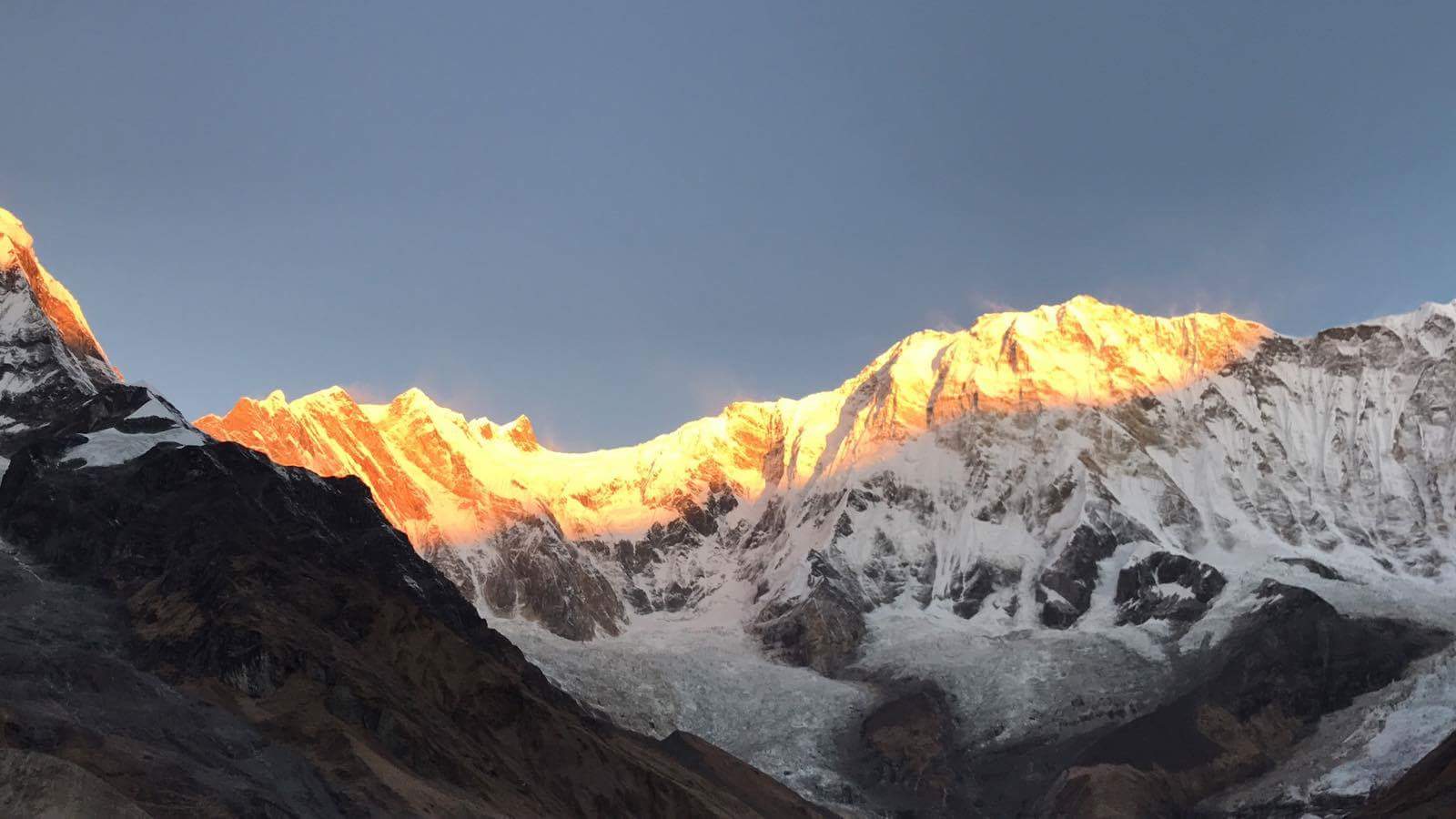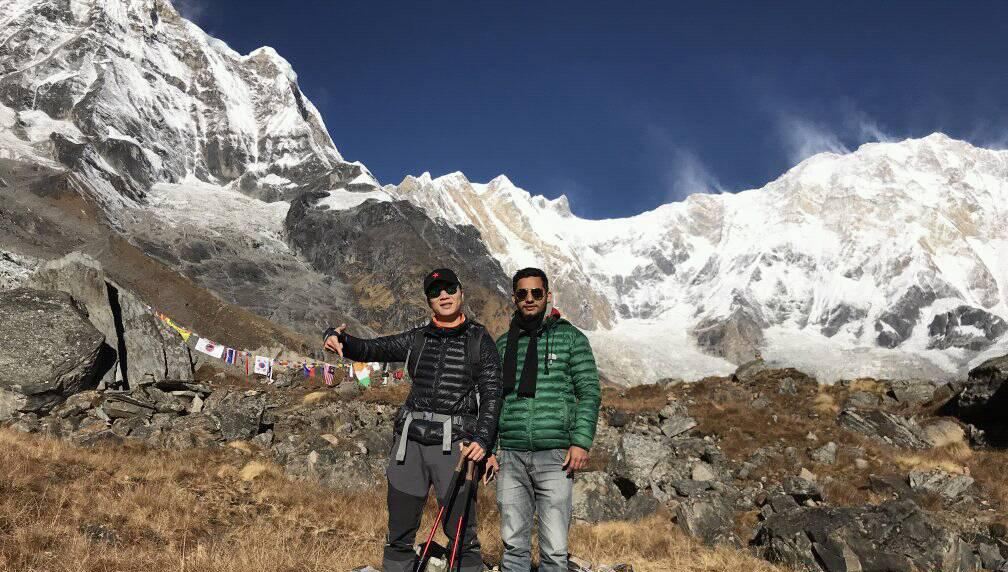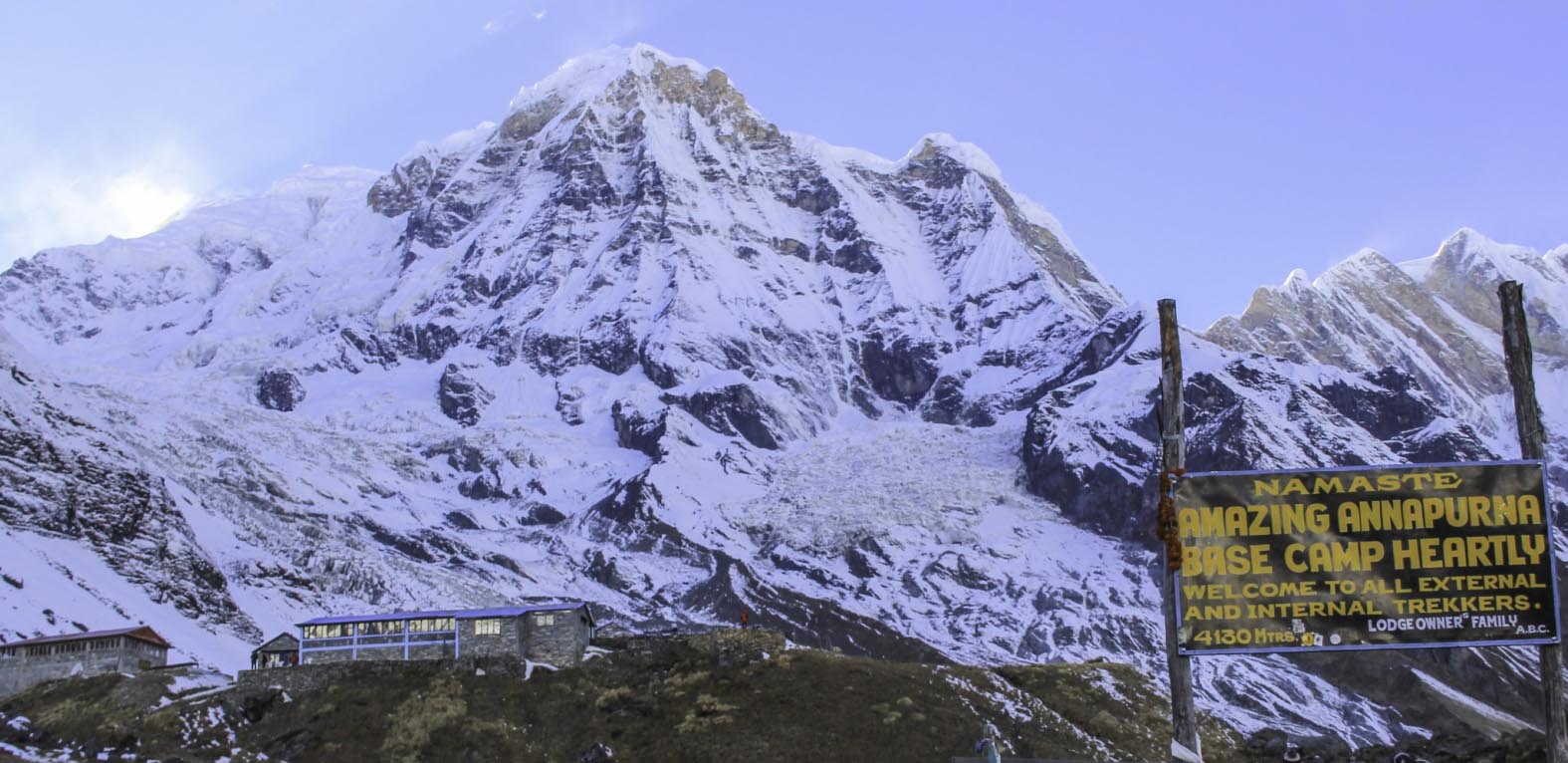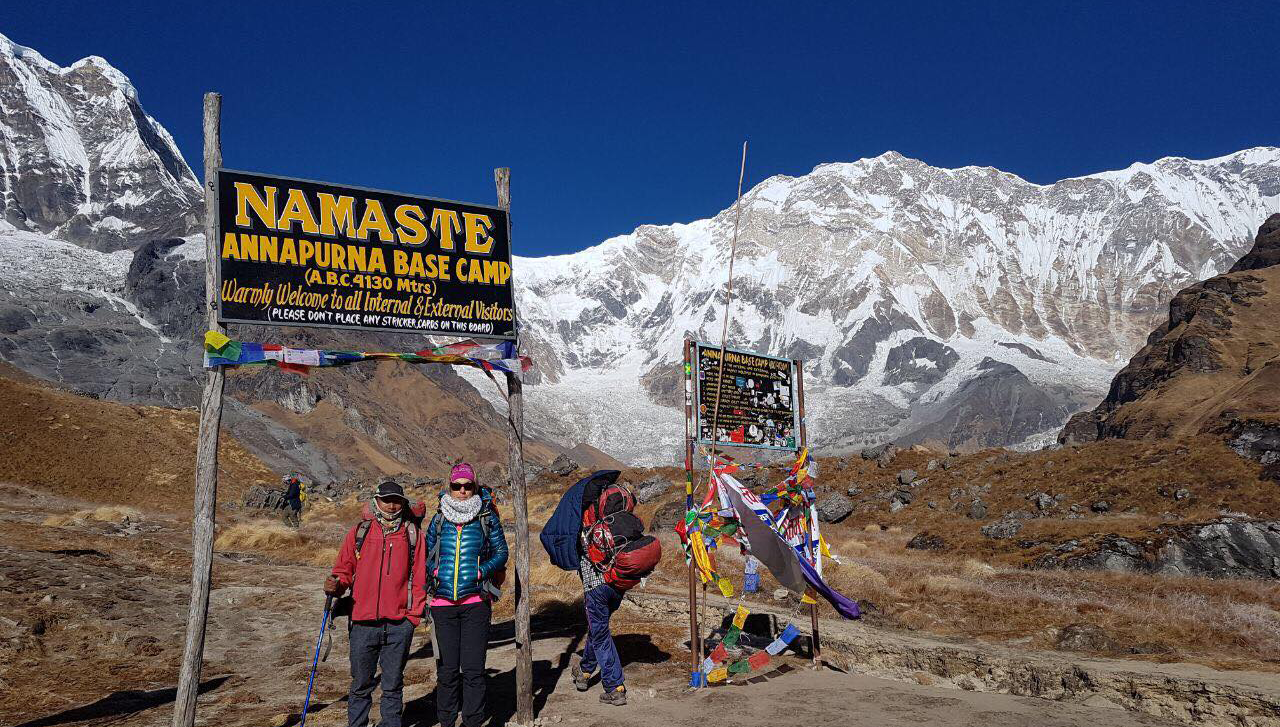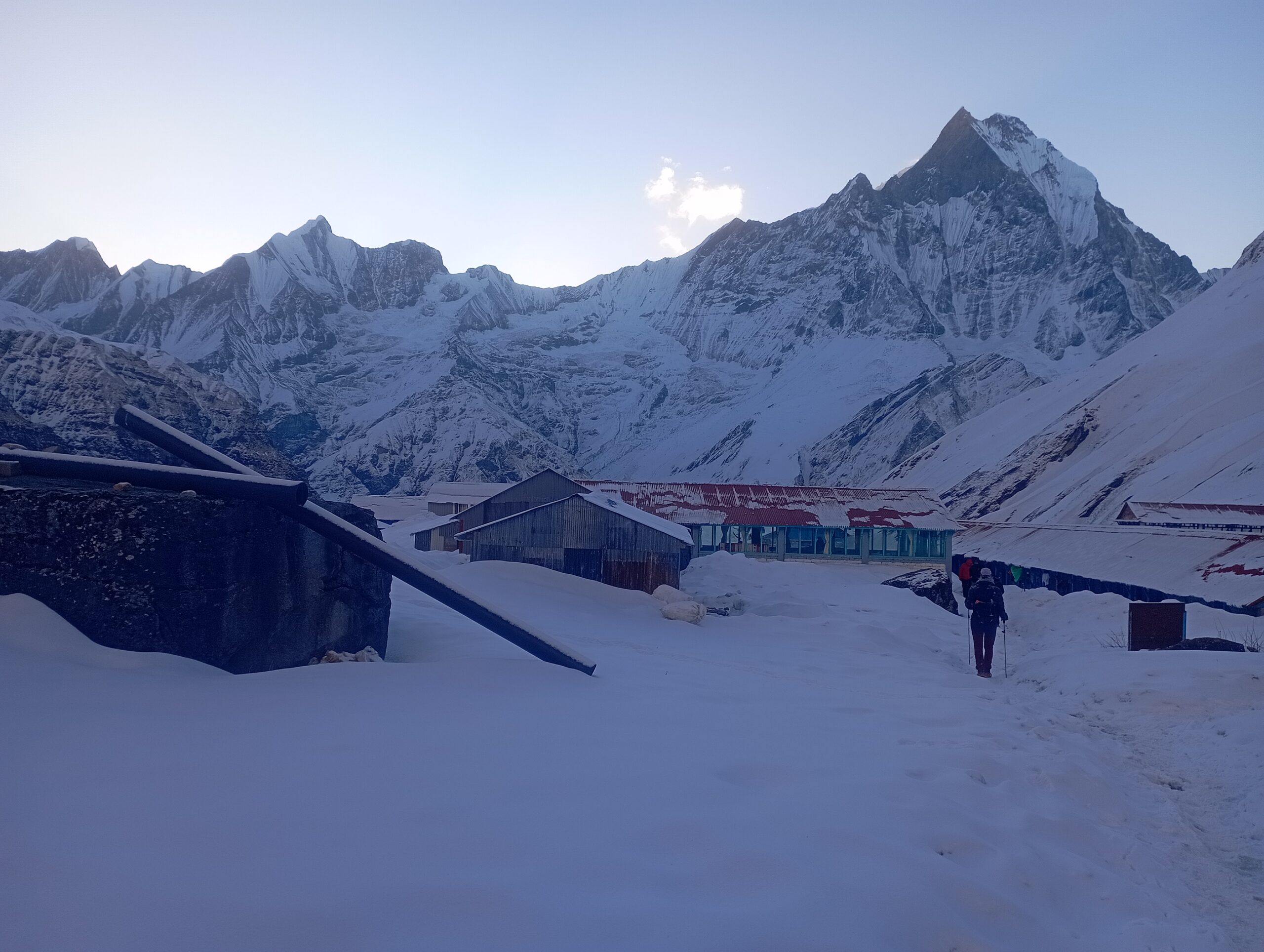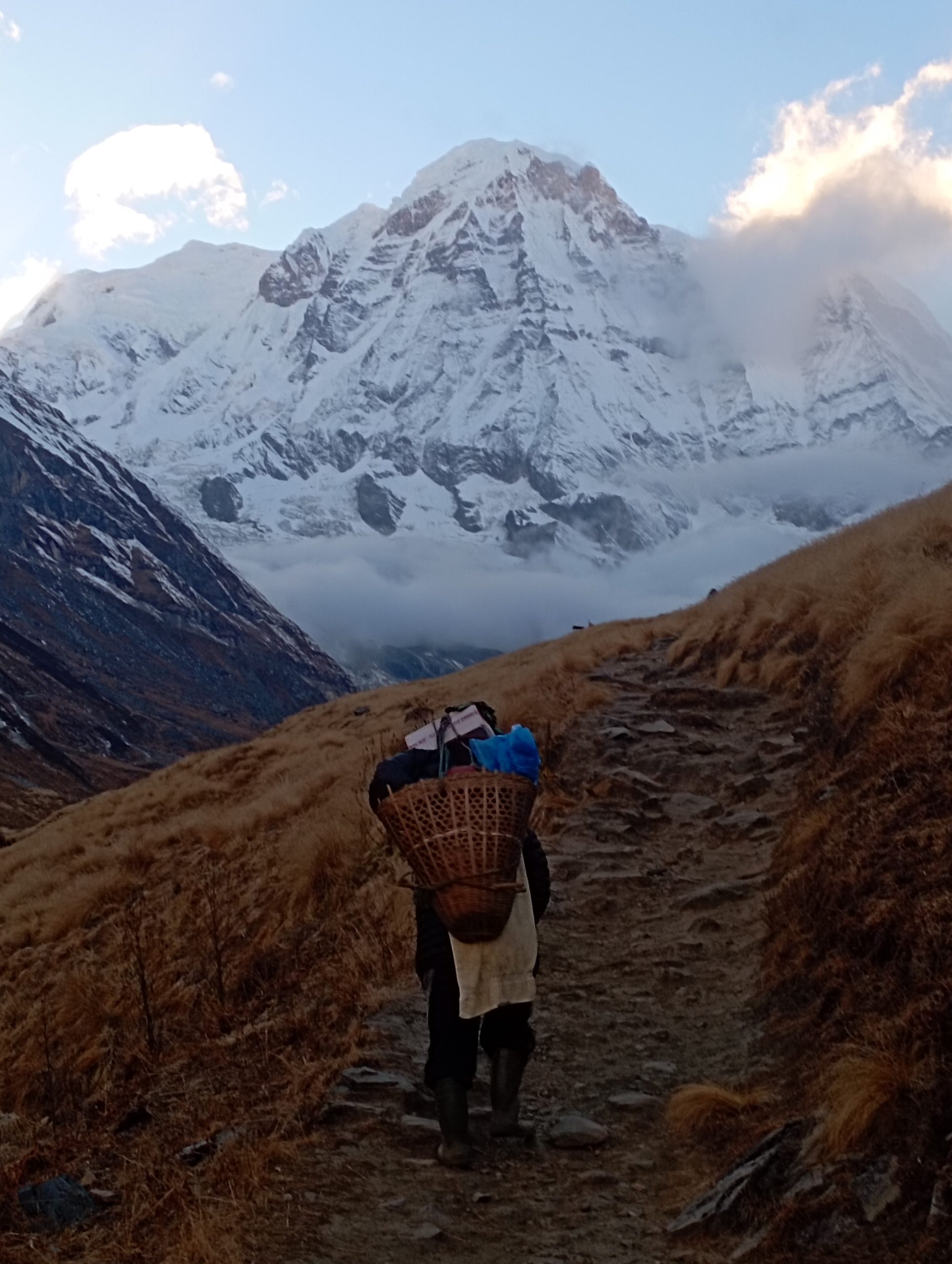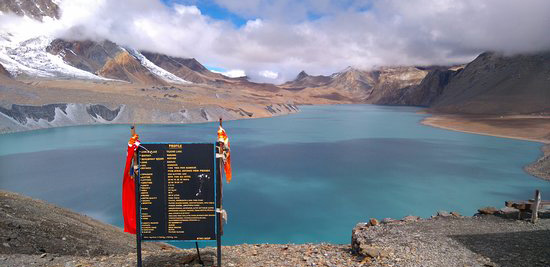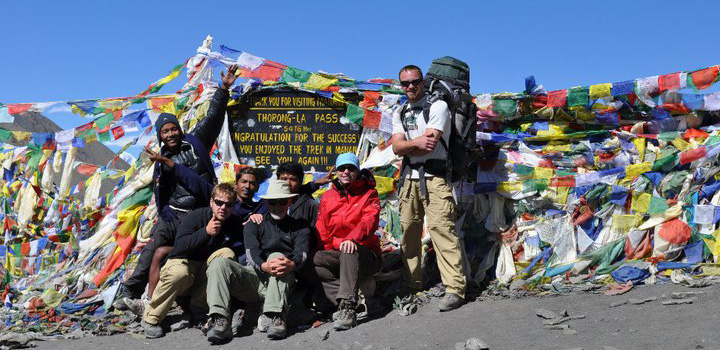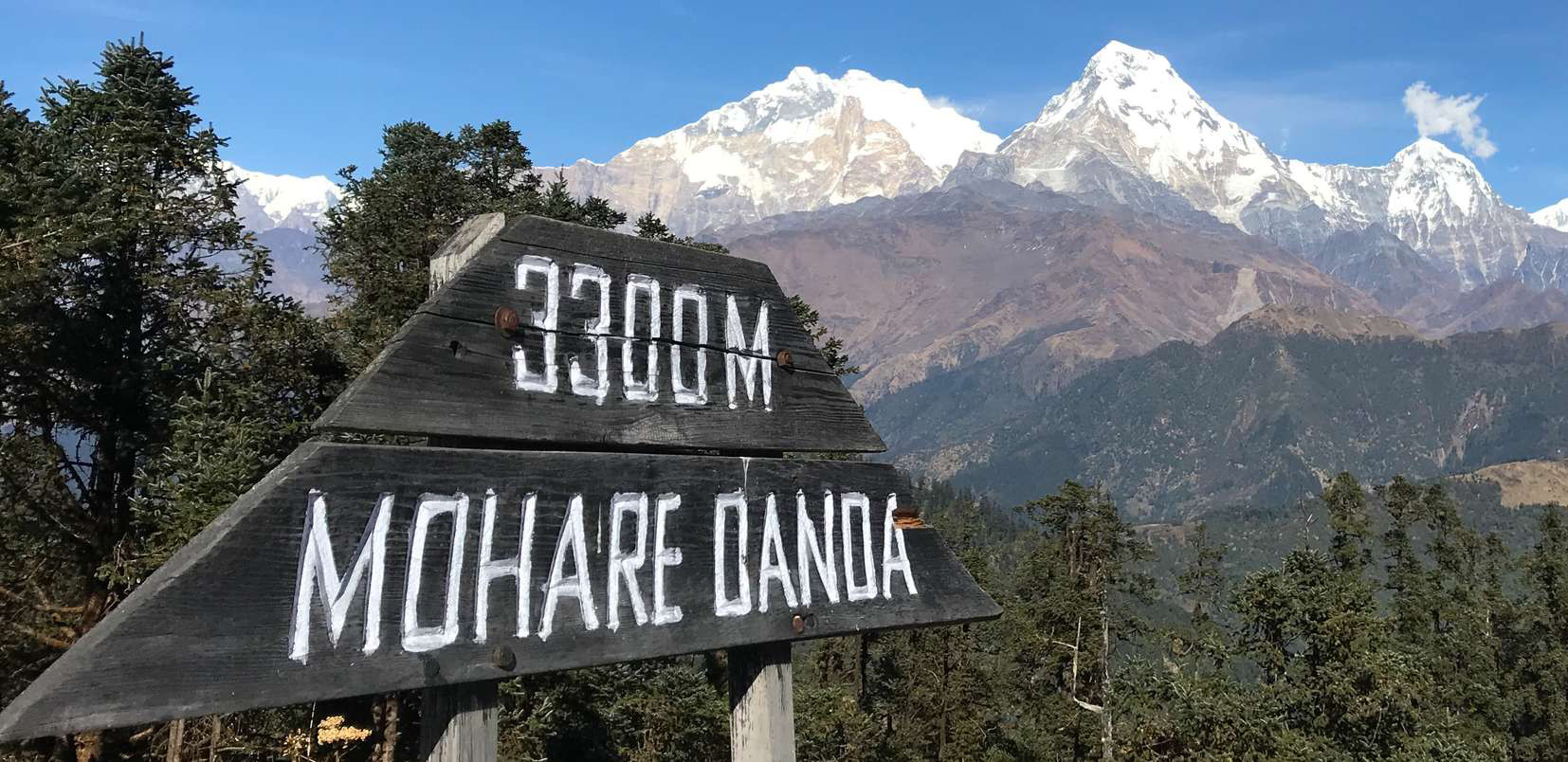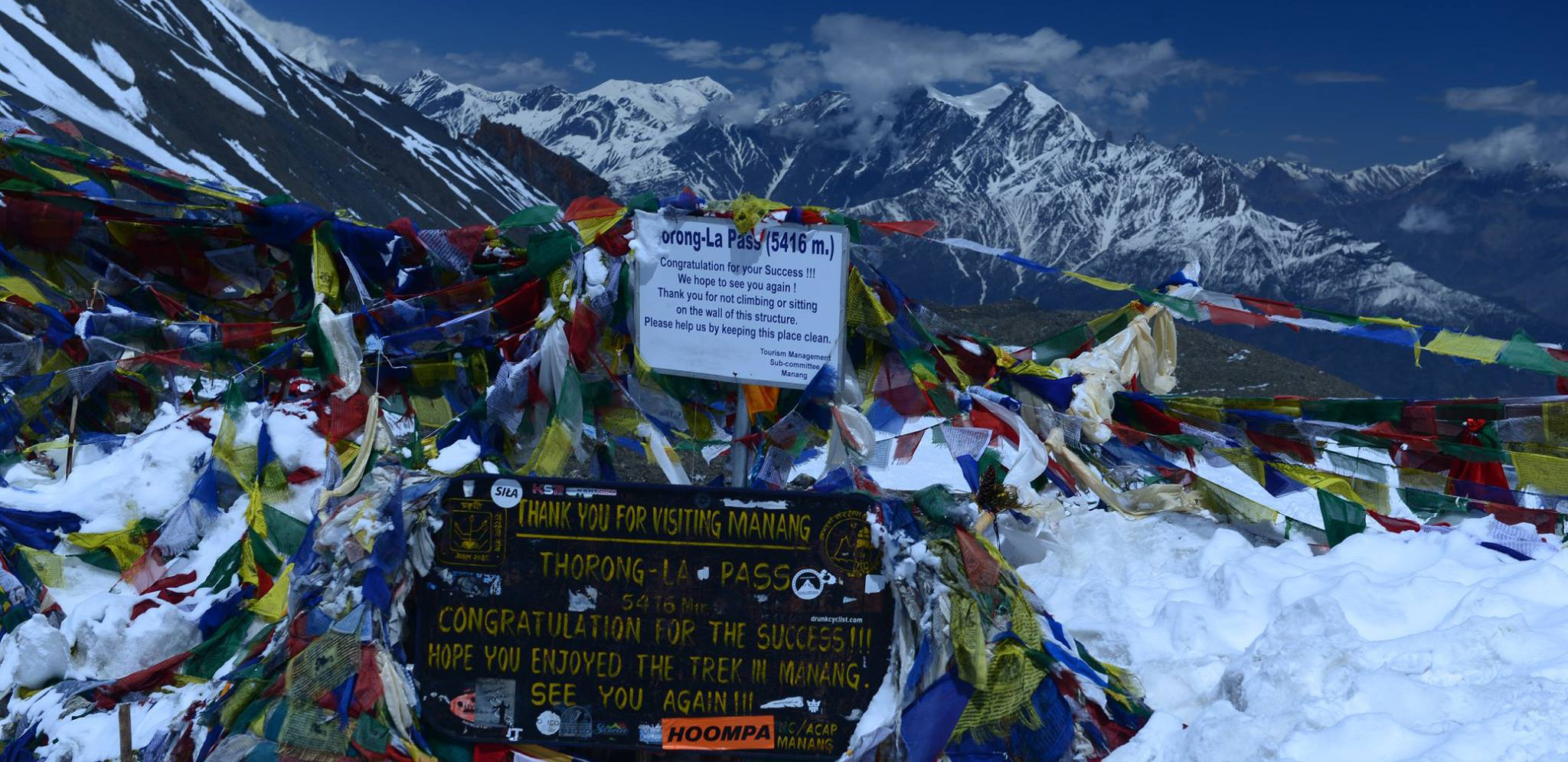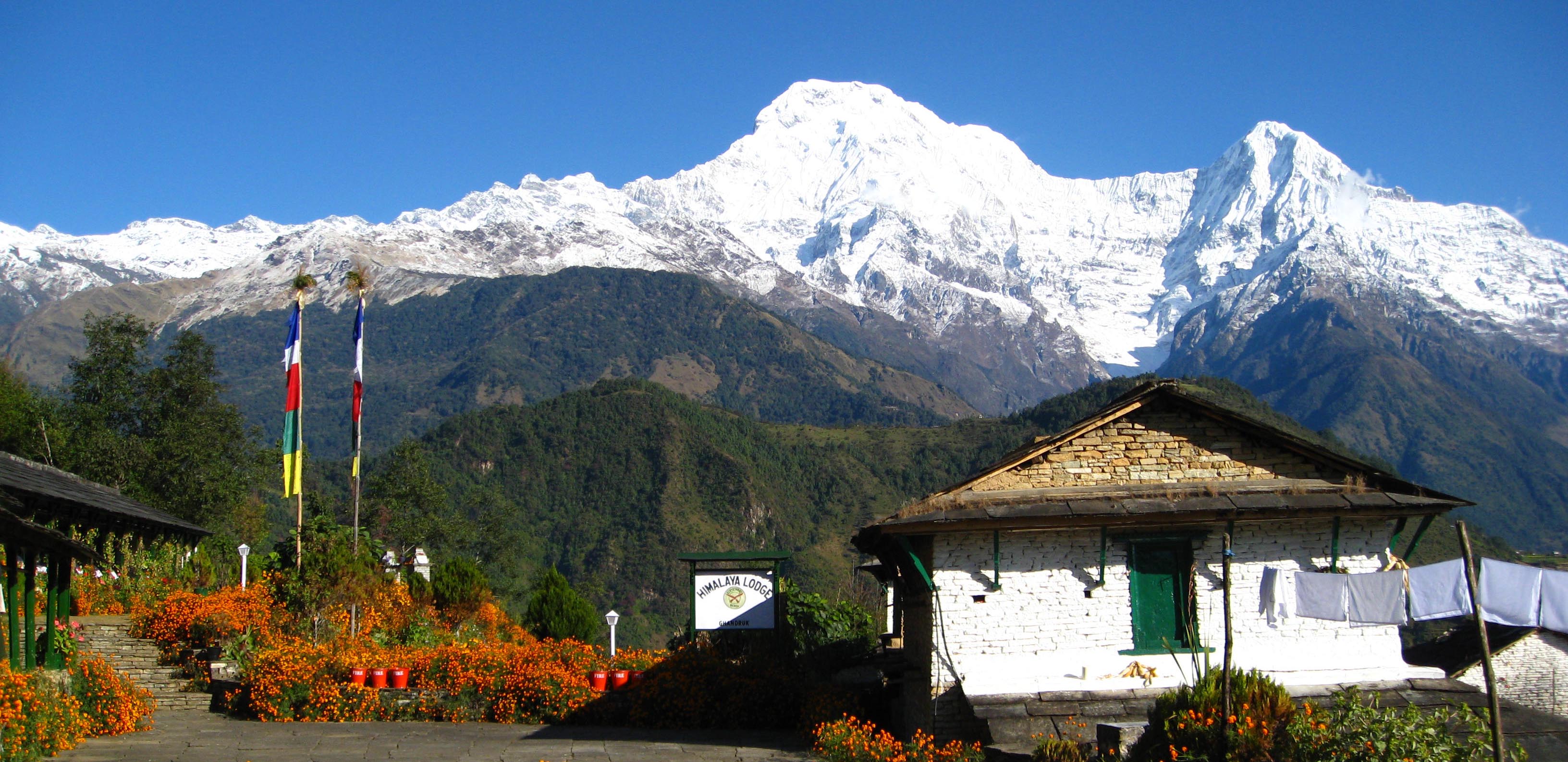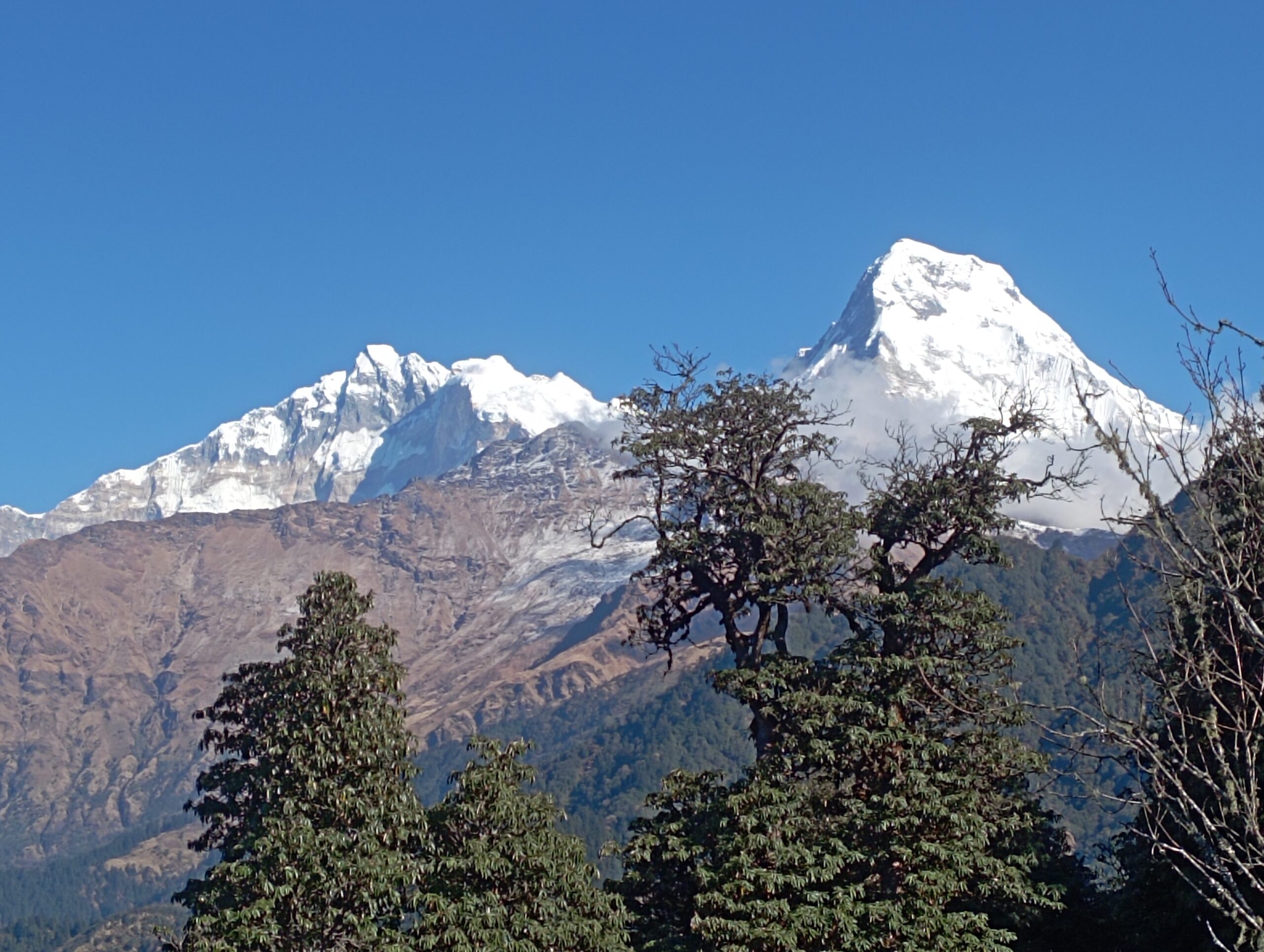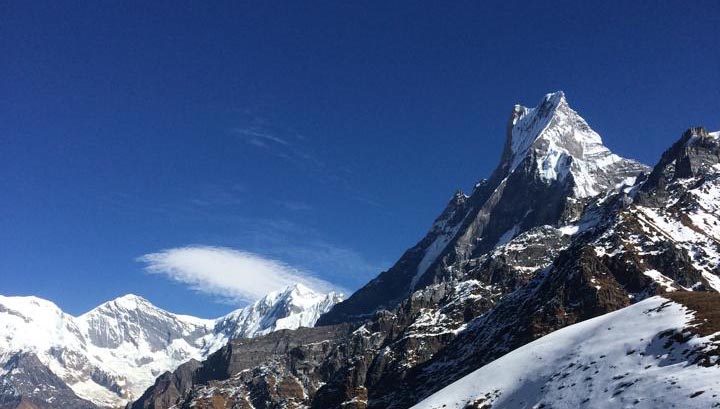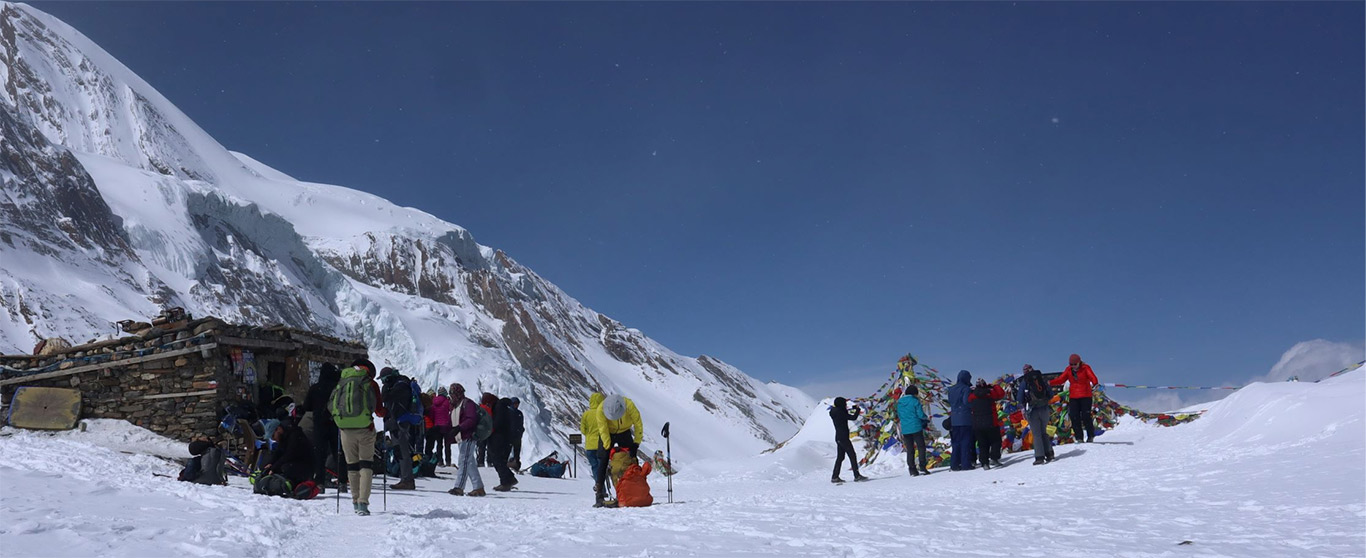Annapurna Base Camp Trekking
Annapurna Base Camp Trekking is often regarded as one of the best Trekking & Hiking Destinations in the world. This trek promises you spectacular views of the Himalayas, along with the diverse culture and traditions of people residing there. Annapurna Base Camp begins following a 30-minute flight or 7 hours of drive into Pokhara. Another 30-minute drive to Phedi finally takes you to witness the tenth-highest peak in the world, Mt. Annapurna. The trek goes through the villages of Magar and the Gurung community. As you climb up, you will pass through the dense forest of pine, and rhododendrons with a view of lovely mountains in the backdrop. Annapurna Base Camp Trekking is a chance to explore the mountains, hills, culture, and traditions of western Nepal. This trekking package will give you a chance to witness World Heritage sites in Kathmandu along with a lifetime experience of a trek to Annapurna Base Camp.
Day 01: Arrival in Kathmandu(1,300m/4,264ft)
Day 02: Kathmandu Sightseeing and trek preparation(4 – 6hour)
Day 03: Drive to Pokhara(895m / 2936feet)(7 – 9 Hour)
Day 04: Trek to Ulleri(2045m/6709feet) 5 – 7 hours trek
Day 05: Ulleri (2045m/6709feet) to Ghorepani (2,750 m/9,020 ft): 4 – 5 hours trek
Day 06: Ghorepani to Tadapani (2,700m/8,860ft) with a visit to Poon Hill (3,210m/10,529ft): 5 – 7 hours
Day 07: Tadapani to Sinuwa(2340 m/7,677 ft).(6 – 7 hours trek)
Day 08: Sinuwa to Deurali (3230m/10,595ft): 5 – 7 hours
Day 09: Annapurna Base Camp (4,130m/13,545ft) via Machhapuchhre Base Camp (3700m/12135ft): 5 – 7 hours
Day 10: Annapurna Base Camp to Bamboo (6 – 7 hours)
Day 11: Bamboo to Jhinu Danda (1760m/5770 ft)5 – 7 hours
Day 12:Jhinu Danda (1760m/5770 ft) to Tolkha (1,710m/ 5,610 ft)5 – 7 hours
Day 13: Trek to Naudanda Phedi then drive to Pokhara, 5 hours trek, 20 min drive
Day 14: Drive from Pokhara to Kathmandu
Day 15: Departure Day
Important Note
All of the requirements listed in the itinerary above apply to visitors who would prefer a complete package tour. We also cater to your preferences at the same time. The vacation schedule above can be altered to suit the needs of individual guests and can be either shorter or longer. We take this into account while designing your vacation. Due to circumstances outside of our control, the aforementioned itineraries could alter. This guideline indicates approximate night stops. Natural, technological, and physical conditions could alter the aforementioned itineraries.
Day 01: Kathmandu Arrival (1,300m/4,264ft)
You will be welcomed by our representative after you arrive in Kathmandu. You will be transferred to your hotel. Stay overnight at your hotel in Thamel, Kathmandu.
Day 02: Kathmandu Valley Sightseeing (4-6hr)
You will visit the major world heritage sites and beautiful attractions around the valley throughout today. Some of these might be:-
Durbar Squares
Three durbar squares in the valley representing the major cities of Kathmandu, Bhaktapur, and Lalitpur (Patan) here resemble the rich history, art, and culture of the Kathmandu Valley. Among them, you will visit Patan Durbar Square.
- Patan Durbar Square:
Patan Durbar Square is a fascinating combination of palace buildings, artistic courtyards, and graceful pagoda temples. The Krishna Mandir (Temple) from the 17th century is a major attraction. The patanPatan museum contains bronze statues and other religious objects which has great significance. Durbar Square has both religious and cultural importance and the surroundings are artistically beautiful. - Pashupatinath Temple:
The Pashupatinath Temple is one of the most significant Hindu temples in Asia with over 500 small and big shrines, Lingams, and temples in the temple complex. - Boudhanath Stupa:
The largest stupa and center of Tibetan Buddhism that is in the Kathmandu valley. One of the best places to relax and take a hint of Buddhist culture is in Kathmandu.
After the Sightseeing, we will drive you back to the hotel. - Swayambhunath Temple:
Also known as the ‘Monkey Temple’, this is one of the oldest heritage sites in Nepal. From the top viewpoint, you will have an amazing view of the capital city “Kathmandu”.
Included Meal: Breakfast
Day 03: Drive to Pokhara (895m / 2936 feet) 7 – 9 hour
Our trekking staff will pick you up at the hotel at around 6:30 am and escort you to the tourist bus station. The bus leaves at around 7:00 am to Pokhara. Pokhara is also known for its panoramic views of Annapurna, Dhaulagiri, Lamjung, and Manaslu. It is smaller and much less crowded comparing Kathmandu providing the perfect starting point for our trek.
Included Meal: Breakfast
Day 04: Drive to Nayapul (1,010 m) and Trek to Ulleri(2045m/6709feet) 5 – 7 hours
We will begin our trek at Nayapul after an hour’s drive on a private vehicle from Pokhara. We will reach Birethanti (1,015 m), after a short minute walk on Modi Khola. Birethanti is a large village with many teahouses and shops. The trail climbs gradually up the side of the Hile Valley. We will reach Tikhedhunga, after a short climb. Today’s walk is comparatively short and easy, a preface to the trekking experience in the Annapurna region.
Included Meals: Breakfast, Lunch, and Dinner
Day 05: Trek to Ghorepani (2,850m/9,350ft) 4 – 5 hours
We will move on towards the steep climb to a large Magar village Ulleri. The trail ascends mildly from this point, through lush forests of pine, oak, and rhododendrons. Then we will trek towards Nangethanti and after an hour’s walk, we will arrive at Ghorepani (2,840 m).
Included Meals: Breakfast, Lunch, and Dinner
Day 06: Ghorepani to Tadapani (2,700m/8,860ft) with a visit to Poon Hill (3,210m/10,529ft) 5 – 7 hours
We will get up early in the morning to reach Poon Hill just in time to see the sunrise over the Himalayas. Poon Hill is the most popular destination to enjoy close-up views of the Annapurna and Dhaulagiri ranges and enjoy the sunrise from these majestic mountains. From Poon Hill, we will also get incredible views of Mustang, Pokhara, and more than 20 of the highest mountains. After enjoying a cup of tea/coffee, we will trek back to Ghorepani. After having breakfast here, we will walk towards climbing a ridge. Our trail descends through woods and cascades before we reach Tadapani. Stay overnight in Tadapani.
Included Meals: Breakfast, Lunch, and Dinner
Day 07: Tadapani to Sinuwa(2340 m/7,677 ft).(6 – 7 hours trek)
Our trail opens up to beautifully terraced fields. We will walk uphill for around 5 km and pass waterfalls and reach a suspension bridge. Suspension bridges are very common in the hilly and mountainous regions of Nepal. A few more miles of ascents and descents and we will reach our destination Chhomrong. It is a beautiful village right below the giant Annapurna massive. Stay overnight in Chhomrong.
Included Meals: Breakfast, Lunch, and Dinner
Day 08: Sinuwa(2340 m/7,677 ft) to Deurali (3230m/10,595ft): 5 – 7 hours
We will wake up with beautiful vistas of the White Mountain from our lodge in perfect weather or else enjoy the morning with a delicious breakfast and a cup of tea/coffee. We will climb on stone steps for an hour to reach Sinwa Danda after crossing the suspension bridge over Chhomrong Khola. We will pass through a bamboo forest that is damp and cold. We then walk uphill on a trail that is sometimes steep. Enjoying and walking through the forests of bamboo, and rhododendron, we will ascent to the Himalayas and then another ascent to reach our destination Deurali. Stay overnight at the teahouse.
Included Meals: Breakfast, Lunch, and Dinner
Day 09: Deurali to Annapurna Base Camp (4,130m) via Machhapuchhre Base Camp (3700m): 5- 7 hours
The trail sticks to a steep rocky cliff. We will walk on a somewhat flat path for a while before ascending to Machhapuchhre Base Camp. From here, we will get excellent views of Mt. Hiunchuli, Annapurna South, Annapurna I, Annapurna III, and surrounding peaks. We then turn left and begin ascending gently to the Annapurna Base Camp. During our climb, we can appreciate remarkable views of the Himalayan panorama. Hiking further we will reach the base camp and the scenery is amazing. We are surrounded by magnificent peaks and the only way into this area is through the gorge we just hiked. Stay overnight at Annapurna Base Camp.
Included Meals: Breakfast, Lunch, and Dinner
Day 10: Annapurna Base Camp to Bamboo (2,300m/7,544 ft.) 7 – 8 hours
From Annapurna Base Camp our trail rapidly descends past the Machhapuchhre Base Camp, Deurali, Himalaya, and Dovan, and finally to Bamboo where we spend the night. Today’s trek is downhill so it is easy. Stay overnight in Bamboo.
Included Meals: Breakfast, Lunch, and Dinner
Day 11: Bamboo to Jhinu Danda (1760m): 5 – 6 hours
Today we will trek to Jhinu Danda from Bamboo. We will retrace our step back to Chhomrong where we stop for lunch. We will stop for lunch at Chhomrong. We will descend to reach Jhinu dandaDanda after stepping on stones and crossing Chhomrong through Modi Khola Valley. Enjoy walking through rainforests and farms before reaching Jhinu. Stay overnight at Jhinu Danda.
Included Meals: Breakfast, Lunch, and Dinner
Day 12: Trek from Jhinu Danda to Tolkha (1400mtr) Via Landruk (5 -7 hours)
We will start our trek to Tolkha village via Landruk after our breakfast. You will feel in love with the stunning views of mountains, cultivated farms, and the culture and tradition of the people living there. Spend a night there and enjoy the warm hospitality of the locals.
Included Meals: Breakfast, Lunch, and Dinner
Day 13: Trek to Naudanda Phedi then drive to Pokhara (3 – 5 hr Trek, 20min Drive)
We will bid farewell to Tolkha village, enjoy the magnificent views, and trek forward to Naudanda Phedi. We will drive back to Pokhara. Stay overnight in Pokhara.
Included meals: Breakfast, and Lunch
Day 14: Drive back to Kathmandu (6-7hr)
In the morning, we will be driving back to Kathmandu. We will take you for a cultural dinner in the evening as successful completion of the Nepal trip. Stay overnight in Kathmandu.
Included Meals: Breakfast
Day 15: Departure Day
Our driver will transfer you to the airport approximately 3 hours before your scheduled flight to connect to the international flight.
Included Meals: Breakfast
Price Included
- Pickups and drops from Airport.
- Accommodations in 3-star Category hotels in Kathmandu and Pokhara including breakfast.
- Teahouses/Lodge Accommodation including Breakfast, Lunch, and Dinner during the trek.
- Farewell dinner at the end of Trek.
- Himalayan Sanctuary Adventure Duffel Bag
- Transportation by Tourist Coach (Kathmandu – Pokhara – Kathmandu)
- An experienced English-speaking Trekking guide and porters to carry luggage (2 trekkers: 1 porter) including their salary, insurance, equipment, food, and lodging
- All necessary paperwork and permits (ACAP, TIMS )
- A comprehensive medical kit
- All government and local taxes
Price Excluded
- Nepalese visa fee
- International airfare to and from Kathmandu
- Excess baggage charges
- Entrance Fee for Sightseeing
- Lunch and dinner in Kathmandu and/or Pokhara
- Extra night accommodation in Kathmandu and Pokhara in case of early arrival, late departure, and early return from the mountain(due to any reason) than the scheduled itinerary
- Travel and rescue insurance
- Personal expenses (phone calls, Tea, Coffee, hot and cold drinks, laundry, bar bills, battery recharge, extra porters, bottle or boiled water, Hot shower, etc.)
- Tips for guides and porters
Features of Annapurna Base Camp Trek
- Popular trek
- First Summited Mountain
- Renowned as ‘Photographer’s Paradise’
- Charming ethnic villages, local people, culture, and lifestyle
- Sunrise view and Breathtaking snow-capped peaks
- Awesome views of Machhapuchhre, Annapurna, and Dhaulagiri ranges
Accommodation during the Annapurna Base Camp Trek
Lodges or teahouses with basic facilities such as beds, blankets, and pillows are accommodation types during the Annapurna Base Camp Trek. The availability of attached bathrooms is there in the lower regions only. As you go higher, the bathrooms are outside the teahouses. The additional facilities like using Wi-Fi, charging electronic devices, laundry, hot shower, etc. Need to pay an extra.
Meals during the Annapurna Base Camp Trek
The 3-course full-board meals are provided during the Annapurna Base Camp Trek. Meal options are limited. Dal-Bhat is the primary option with some options like soup, eggs, noodles, hot tea, etc. available.
Drinking Water during the Annapurna Base Camp Trek
No mineral are allowed from Chommrong there will be Bottled water, Tap water, and boiled water are drinking water options during the Annapurna Base Camp Trek. Pay an extra cost for boiled water at teahouses or lodges or buy bottled water as a preference. For safe drinking water, carry water purification kits and a water bottle for ease.
Internet and Phone Networks during the Annapurna Base Camp Trek
Internet and Phone networks during the Annapurna Base Camp Treks are stable mostly in the lower regions. In the higher regions, networks are unstable. For the use of Wi-Fi, pay an additional cost at teahouses.
Best Season for the Annapurna Base Camp Trek
Spring (Mar-May) and Autumn (Sep-Nov) are the best seasons for the Annapurna Circuit with Nar Phu Trek. The clear weather, stable temperatures, awesome panoramic vistas, and comfortable trekking trails make these seasons ideal for this trek. The rainy (Jun-Aug) and winter (Dec-Feb) seasons are not ideal due to unpredictable and unstable weather and temperature. The trekking trails are slippery, muddy, or snowy, and the availability of accommodations is limited. But the Nar Phu trek is doable in these seasons with proper planning and preparation.
Annapurna Base Camp Trek Difficulty
The highest elevation during Annapurna Circuit with Nar Phu Trek is Kang La Pass which lies at 5322 m. Annapurna Circuit with Nar Phu Trek is difficult considering its ascends and descends, high elevations, daily long hours of walking, rough trails, and limited availability of teahouses or lodges. Also, the chances of getting altitude sickness are common. Thus, acclimatization rest is essential. With proper preparation, this trek is possible.
Altitude Sickness and Preventions during the Annapurna Base Camp Trek
Altitude Sickness is common in the Annapurna Base Camp Trek. To prevent it, acclimatization rest is essential. Thus, utilize rest days properly to adapt to the surroundings.
Symptoms of altitude sickness are headache, nausea, and breathing issues. Inform your guides if you experience any symptoms during the trek.
Preventive measures for Altitude Sickness are:
- Stretch and warm up before trekking.
- Stay hydrated with regular water intake.
- Ascend gradually and rest well.
- Avoid salt, alcohol, and smoking.
- Urinate frequently.
- Descend if feeling unwell.
- Consult guides for medicine
Fitness Level during the Annapurna Base Camp Trek
Annapurna Base Camp Trek is demanding due to its challenging terrain, daily long hours of walking, high elevations, several ups and downs, and rugged trails. Thus, a strong fitness level is a key factor for this trek. Therefore, we recommend trekkers participate in physical exercises and short hikes for a few months, and necessary physical check-ups before commencing this trek.
Travel Insurance during the Annapurna Base Camp Trek
Travel Insurance is a safety tool for trekking in the mountains. It should cover all emergencies including medical costs, loss of goods, flight delays, evacuation, and high elevations above 5000 m. For a worry-free and smooth Annapurna base Camp Trek, getting travel insurance is beneficial.
Guides and Porters during the Annapurna Base Camp Trek
Annapurna Base Camp Trek compulsory requires a guide. Porters are optional but for a comfortable trekking experience hiring a porter is the ideal decision. Our guides and porters are professional and have lots of experience in the mountains. Our team ensures trekkers’ safety as it is the top priority.
Annapurna Base Camp Trek Permits
The required permits for Annapurna Base Camp Treks are as follows:
- Annapurna Conservation Area Permit (ACAP)
USD 30/person (Foreigners)
NPR 1000/person (SAARC)
This equipment list is only a guideline. You need to bring the listed items, however, you can choose from your preferred brands using your expertise. You can also shop the below equipment and clothing at a reasonable price at stores in Thamel, Kathmandu. The personal items are of individual interest and choice. The most important fact that one should keep in mind is that one should have enough clothes to tackle the cold weather in the Himalayas.
Upper Body – Head / Ears / Eyes
- Sun hat
- Wool or synthetic hat that covers the ears
- Sunglasses with UV protection
- Headlamp
- Neck warmer
Hand
- Liner gloves
- Heavier shell gloves
Core Body
- T-shirts (2)
- Lightweight expedition thermal tops
- Fleece jacket or pullover
- Water/windproof shell jacket (Preferably breathable fabric)
- Synthetic sports bras (for women)
Lower Body – Legs
- Lightweight expedition thermal bottoms
- Nylon hiking shorts
- Soft shell and hard shell trekking pants
- Water/windproof trousers
- Casual pants
Feet
- Liner socks
- Heavyweight socks
- Waterproof hiking/trekking boots
- Light shoes/sneakers
- Gaiters (For monsoon and winter)
Other Essential
- Passport and extra passport photos (2 copies)
- Airline tickets (Please make a copy and leave one at our office in KTM just in case you need to change the date of yours)
- Durable wallet/pouch for travel documents, money & passport
- Water bottle/bladder
- Water purification Iodine tablets
- Toiletries (Include toilet paper, wet wipes, and liquid hand sanitizer, towel, soap)
Medicines and First Aid Kit
- Extra Strength Excedrin for altitude-related headaches
- Ibuprofen for general aches and pains
- Immodium or Pepto bismol capsules for upset stomach or diarrhea
- Diamox (commonly prescribed as Acetazolamide) 125 or 250mg tablets for altitude sickness
- Anti-infection ointments
- Band-aids
- Lip balm (At least SPF 20)
- Sunscreen (SPF 40)
Optional
- Adjustable trekking poles
- Favorite snacks
- Cameras (Memory cards, chargers and, batteries)
Fitness Level: This Trip Requires you to be in Good Health with Physically Fitness.
Skills: Your familiarity with the mountainous terrain and previous trekking experience will be plus points.
Note: This equipment list is only a guideline. You need to bring the listed items, however, you can choose from your preferred brands using your expertise. you can also shop the above equipment and clothing at a reasonable price at stores in Thamel, Kathmandu.
- What type of shape do I need to be in, is this trip for me?
Annapurna base camp trek is suitable for average people who are moderately fit, thus no previous experience is required. Some physical fitness programs such as running, swimming, and hiking is recommended before you embark on your journey. Persons suffering from a pre-existing medical condition must seek medical advice/consent before considering the trek. - Is it possible to reserve a trip now and pay a deposit later or do I Have to pay a deposit at booking/reservation?
Yes! The trip will be confirmed only when we receive the completed final booking form and a 30% deposit payment. You can pay the balance of the money when you arrive in Kathmandu. - Will somebody come to pick me up from the airport upon my arrival?
Yes, our airport representative from Himalayan sanctuary adventure will be there to greet you at the airport. They will be displaying your name outside the arrival terminal then you will be transferred to your hotel overnight. - What sort of accommodation can I expect in Kathmandu, Pokhara, and during trekking?
We use standard rooms at 2-star Category hotels in Kathmandu and Pokhara including breakfast. Along the trekking routes, teahouses/lodges generally provide basic clean facilities with a mattress and a quilt or blanket. We recommend you have sleeping bags, it is a good idea to always have your sleeping equipment. The lodges in trekking routes usually provide single and double rooms, or occasionally a dormitory style. At times when possible, dining will be around a bonfire. In teahouses, food will be prepared in the kitchen, which you should not enter without permission. The toilet in teahouses provides essential and basic facilities and is always outside the room. - Are the guesthouses heated?
The guesthouse does not facilitate with heater or air conditioner. However as it gets colder above 3,500m, they do have the facility of hitting the dining area by providing kerosene or metal heater. USD 1 to USD 3 per person would be applicable to use this service and this is payable directly to the guesthouse. - Where do we go to the toilet along the trail?
Wherever possible we utilize the toilet facilities provided by the tea houses/lodges on the trail. However, in case of emergency trekkers are recommended to find a private, scenic spot! - What are the Toilet facilities in the tea house/guesthouse?
Most of the tea houses do have western-style flushing toilets however tea houses at higher elevations you could find the squat toilets made of either a ceramic basin on the ground or a few planks precariously positioned over a hole in the ground which is always outside. - What is the best season for this trekking?
Our trekking season extends from mid-September to May. From early September the monsoonal rains decrease. By the end of September through to December, the weather is usually stable with mild to warm days, and cold nights. February, March, April, May, October, November, and December is the best time to do Annapurna Base Camp Trek. - Is the food in the mountain prepared to international standards in terms of safety?
Yes, the food is very safe during the trekking but we recommend you eat vegetarian and local food. - Is water provided and is there still water available at higher altitudes? Is it filtered/boiled?
Bottled water is easily available at the lodges and tea houses. You can buy bottled water at the cost of USD 2 at lower elevations to USD 4 at higher elevations per littler. You can also drink the normal tap or spring water if you bring the purifying aid with you. - Is there a possibility of getting separate rooms for the trip? If so how much extra will this cost?
Normally the lodges have twin-sharing and dormitory-styled rooms. The lodges will provide a private room for one person when available. In Kathmandu, USD 45 Per Room per Night would be added as a single supplement fee. The single supplements are always guaranteed in Kathmandu but not in the mountains especially during the peak time. - What immunizations will I need?
No vaccinations are compulsory in the Himalayas, but we do recommend you are covered for diphtheria & TB, hepatitis A, hepatitis B, Malaria, typhoid, polio, and tetanus. We also recommend: A dental check-up before traveling. That you know your blood group in case of emergency. - What if I am very sick in the mountain?
Our guides are 24 hours available for services during the trek. They are trained to use the first aid kit and have the knowledge to use an Oxy meter. They are very much aware that the higher the altitude the oxygen level gets lesser so to get updated on the oxygen level of our client and to know whether they are fit enough or need extra precautions to continue. Guides carry local sim cards for both Nepal Telecom and Ncell to update the whereabouts and the situation of every client. During the time of emergency, our guides are alert and keep updated with the head office in Kathmandu which is available 24 /7 to arrange from horse to mules or helicopters in the most needed cases especially when the client is seriously sick in the mountain and needed to be hospitalized. - Can I obtain a visa for Nepal upon arrival at the airport?
Yes, you can obtain a visa easily upon your arrival at Tribhuvan International Airport in Kathmandu. A tourist Visa with Multiple entries for 30 days can be obtained by paying US $ 40 or equivalent foreign currency. Similarly, a Tourist Visa with Multiple entries for 90 days can be obtained by paying US $ 100. Please bring 2 copies of passport-size photos. - How much additional money do I need per day?
It depends on your spending habits. Generally, in Kathmandu and Pokhara, you can allocate USD 10 to USD 15 for lunch and dinner. USD 20 to USD 30 per person a day will be enough to buy meals, bottles of water, and chocolates, pay for the hot shower, and a few drinks during the trekking. - Can I use credit cards in the places I visit in trekking?
In Kathmandu and Pokhara, yes – to some extent. Once you are out of the cities, all you need is cash. Please change the currency to local Nepali Rupees before you go to the mountains. - What mode of transportation do you use?
We provide you only those options, which enhance your local experience while allowing you to travel comfortably and efficiently. We use private tourist vehicles for sightseeing, city tours, and pickups. Depending on the group size we use cars, minibusses, vans, and tourist buses to and from Kathmandu/ Pokhara. - Is water provided and is there water for drinking available at higher altitudes? Is it filtered/boiled?
Bottled water is easily available at the lodges and tea houses so can buy bottled water at the cost of USD 2 to USD 3 per litter. You can also drink the normal tap or spring water if you bring the purifying aid with you.
| Start Date | End Date | Price in USD | Availability | Booking | Note |
|---|
Avabillity Options
OPEN: This date is available and open for bookings. Go for it!
GUARANTEED: Guaranteed departure. Seat Available.
LIMITED: Guaranteed departure, Limited seat. You can send booking request for availability.
FULL:This date is currently unavailable. Please contact us if you are interested in traveling on this date.

